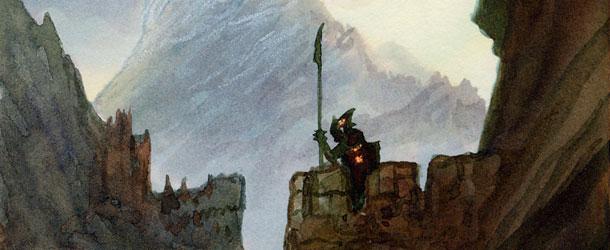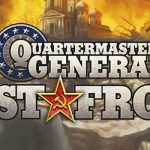The first edition of War of the Ring has been played by hundreds of thousands of people. Over time, and millions of games, strategies evolved which went far beyond what we could imagine when designing the game.
One of the foundations of the game design was that the game should not be broken by finding one or two winning strategies, and that the War of the Ring gameplay should always keep the players on their toes, adapting to the whimsical flow of action dice and cards.
Twilight of the Third Age, the strategy expansion included in the Battles of the Third Age set, had brought a new balance to the game, improving it in many regards. At the same time, this happened at the price of making certain choices – such as bringing Galadriel early in the game, to give an extra action die to the Free Peoples – a real no-brainer.
When developing and testing the Second Edition, we wanted to bring a similar balance, but without making any specific choice so obvious.
When we originally designed of the game, we did not took for granted that the Shadow should muster so quickly the Witch-king and Saruman, as bringing these Minions into the game has nasty side-effects. However, experience had proven that the benefit of the early additional action dice they give to the Shadow is so great to offset these advantages. On the other hand, the Free Peoples player starts with only 4 dice against 7 dice of the Shadow, and a precious 5th die can only be added based upon the unpredictable arrival of Gandalf the White and Aragorn, which depends on the roll of a Will of the West.
Twilight of the Third Age solved this uncertainty thanks to the coming of Galadriel, which can bring the 5th die to the Free People. What should we do, however, to create such a balance without relying on a character from the expansion?
Several solutions were considered, and when the subject came up, several playtesters argued that Aragorn or Gandalf the White should have been easier to bring into the game. However, this choice was somehow contrary to some fundamental concepts of the design. An easier Gandalf the White would make killing off the Grey Pilgrim too obvious –something that we did not like, as discussed in part 6. And an easier Aragorn would make the departure of Strider from the Fellowship too automatic, limiting the diversity of the game. We had to go directly into the main action mechanics of the game, but this required a lot of care, as we were trying to fine-tune the core engine of War of the Ring, the action dice system.
Initially, it looked like a simple solution was at hand. The Shadow had too many dice, and could exploit them in a “rush”, an all-out war to destroy the Free Peoples before the Fellowship could reach Mount Doom, in many cases. If we forced the Shadow player, under certain circumstances, to be forced to place at least one die in the Hunt Box, we would be reducing his available dice, and “force” him a little into a more balanced strategy.
The first attempts we did in this direction, however, proved unfruitful, as it was soon realized by the famous player variously known as Magic Geek, Magic Gecko, or – simply – Glenn. Glenn had developed refined strategies to achieve a Free People Military Victory, and he almost immediately noticed that, if the Shadow was forced to place a die in the Hunt Box no matter what the Fellowship was doing, a really good choice for the Free Peoples player was to avoid moving the Fellowship at all, and just try the FPMV since turn 1. Not very thematic, isn’t it?
After a short but heated discussion, a very good adjustment was soon proposed by Kevin Warrender: if it was mandatory for the Shadow to place a die in the Hunt only if the Fellowship had moved in the previous turn, the abuse of the rule was avoided. This proposal made it into the rules, after going through several months of testing. Another nudge in the direction of balancing the actions between the Free Peoples and the Shadow was done by looking at the way the Minions entered into the game. When we designed the game, we expected Saruman to be in the game in turn 1 or 2, unless you wanted to play without Minions to prevent Gandalf the White entering the game (a strategy that was proven too weak, and that unfortunately is not really possible to try if you want to win the game!). Then, the arrival of the Witch-king should be assessed with care, sometime in the mid-game, to avoid that early activation of the Free Peoples made their defense too strong. Actually, the best strategies developed for the game made the arrival of these two Minion mandatory in turn 1 or 2, using the first 4 Muster results to get them into the game. Could we modify them so that their early arrival would be a more difficult choice, or at least more difficult?
We decided to focus on the Witch-king, because he was the one which in practice was “too early” in the game with respect to the narrative upon which the game is based. The idea of the mustering conditions and effects of the Witch-king is that it is the sign of the start of a total war between Sauron and the Free Peoples. But to have war, you must have TWO armies at war, isn’t it?
So, what would happen if we added as a pre-requisite to the arrival of the Witch-king that at least one Free Peoples Nation should be at war? In theory, this was perfect. This would be a very rare instance in turn 1, sometime possible in turn 2- so the arrival would be delayed at least a little, and if the Shadow wants to rush things and make an attack to force a FP Nation at war, he may do so, but at an additional risk. It was thematic, slowed down the Shadow a little bit, and made the game opening strategy of the Shadow much more diversified than the “4 musters for 2 minions” which had become the “gospel” of Mordor.
The change was almost immediately proven to be a good one, and resisted through the testing, and it is now a part of the 2nd Edition Rules. With the combination of the new rule on the Hunt, and the new entry condition of the Witch-king, the game was definitely more balanced than before. Was any other change still necessary?










